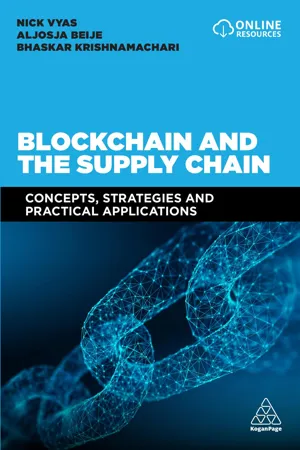
Blockchain and the Supply Chain
Concepts, Strategies and Practical Applications
- English
- ePUB (mobile friendly)
- Available on iOS & Android
Blockchain and the Supply Chain
Concepts, Strategies and Practical Applications
About this book
Blockchain can transform companies when successfully integrated into existing supply chain ecosystems and practices. The key benefits include dispute resolution, foolproof track and trace, event management, operational as well as financial transparency, speed to market, visibility, elimination of heavy reliance on intermediary, integration of IoT technology, machine learning, and artificial intelligence. Blockchain and the Supply Chain highlights how to use blockchain as an enabler and key driver for solutions in the end-to-end supply chain. Blockchain and the Supply Chain examines the business case for blockchain, including increased efficiency of transactions. It also covers the broader set of technologies relevant to supply chains, such as IoT, Big Data and Cyber Security basics and the capabilities they offer. The team of authors look at the evolution of the network, systems and finance, as well as basics of blockchain such as peer-to-peer transactions, consensus-based algorithms and smart contracts. The book includes cases which highlight the opportunities within the different nodes of systems, sales and operations planning and provide practical examples from specific supply chains, such as the movement of temperature-controlled goods, dry goods and precious commodities, as well as general cargo flow.
Frequently asked questions
- Essential is ideal for learners and professionals who enjoy exploring a wide range of subjects. Access the Essential Library with 800,000+ trusted titles and best-sellers across business, personal growth, and the humanities. Includes unlimited reading time and Standard Read Aloud voice.
- Complete: Perfect for advanced learners and researchers needing full, unrestricted access. Unlock 1.4M+ books across hundreds of subjects, including academic and specialized titles. The Complete Plan also includes advanced features like Premium Read Aloud and Research Assistant.
Please note we cannot support devices running on iOS 13 and Android 7 or earlier. Learn more about using the app.
Information
What supply chain management processes and metrics will be affected by blockchain?
Introduction
Table of contents
- List of figures
- List of tables
- Foreword
- Preface
- 01 The evolution of the supply chain: how we got here
- 02 Supply chains in 2018: costly, fragile and increasingly complex
- 03 Basics of blockchain
- 04 Internet of Things, data analytics and other information technologies
- 05 Blockchain strategy: the why, what and how in supply chain management
- 06 What supply chain management processes and metrics will be affected by blockchain?
- 07 Blockchain projects in practice: Case study Deliver
- 08 Blockchain use cases in supply chain
- 09 Economic impact and future outlook
- Acknowledgements
- Index